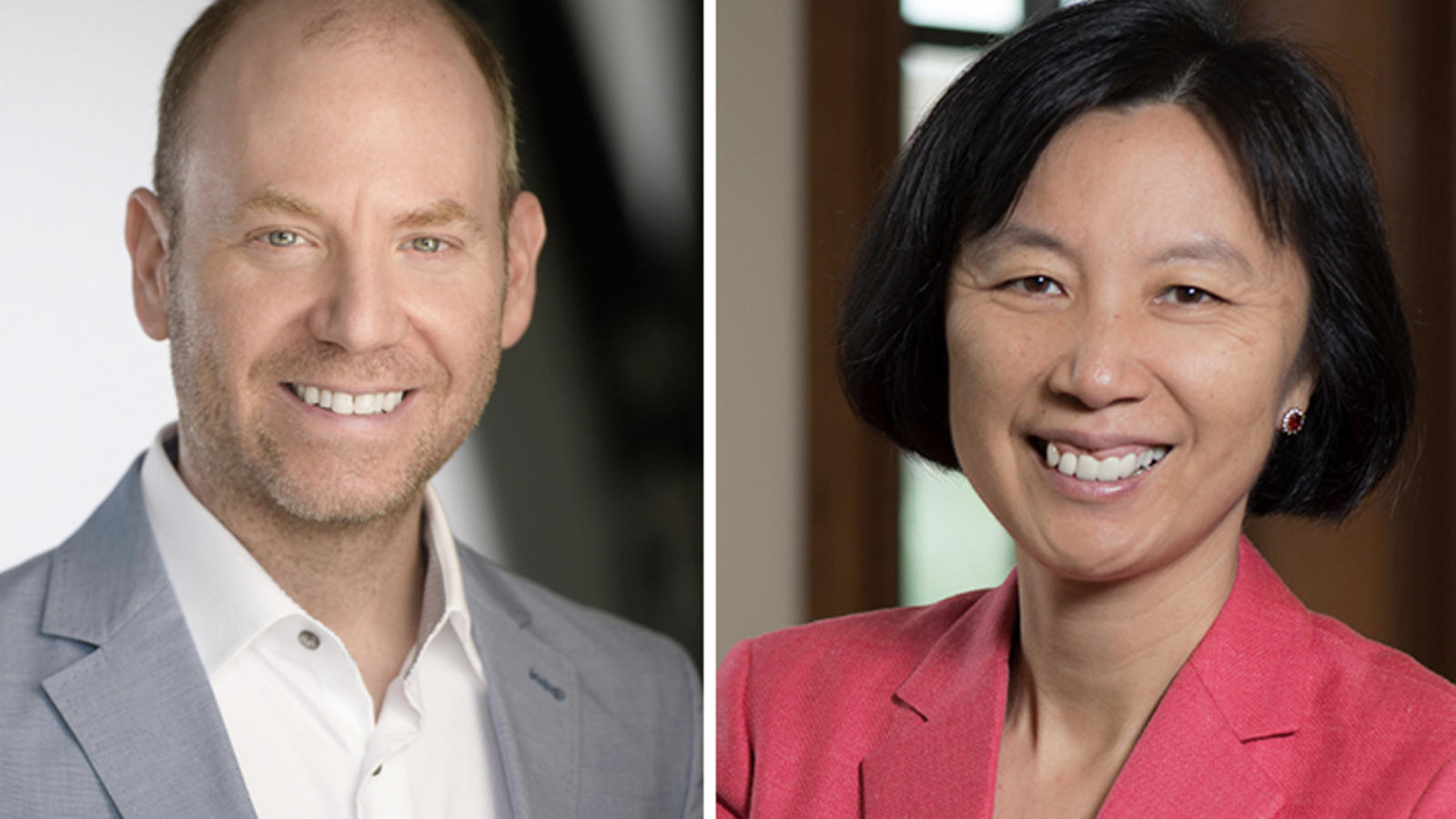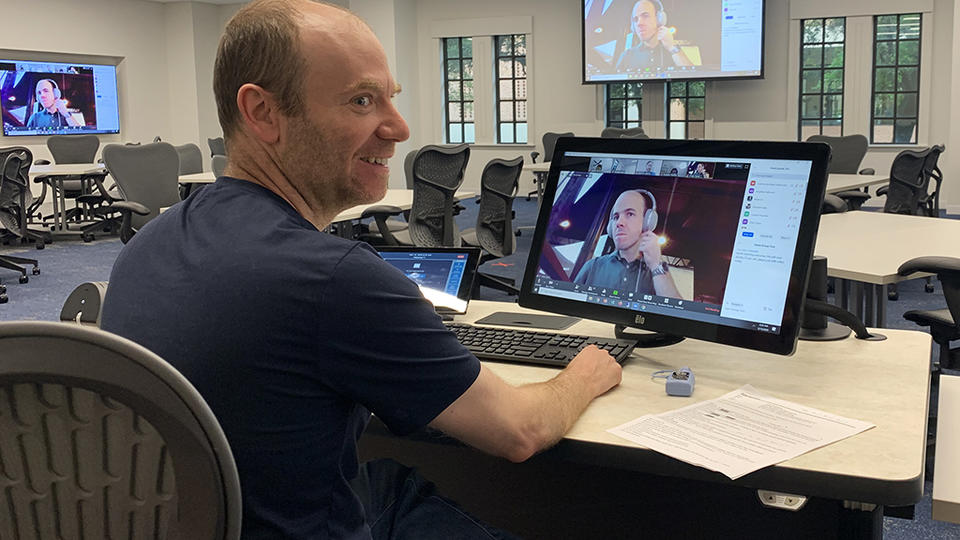Hardship presents opportunity for creativity, Rice Business experts say
The massive disruption of our social and work lives is unnerving, but there are benefits to shaking up our routines and feeling uncomfortable, according to experts at the Jones Graduate School of Business. Scott Sonenshein and Jing Zhou, professors of management, are available to talk about the evolving organizational landscape with news media.


The massive disruption of our social and work lives is unnerving, but there are benefits to shaking up our routines and feeling uncomfortable, according to experts at Rice University’s Jones Graduate School of Business.
Scott Sonenshein and Jing Zhou, professors of management at the Jones School, are available to talk about the evolving organizational landscape with news media.
“I’ve studied creativity for more than two decades, and my research shows that times of disruption and upheaval can lead us to new insights and nudge us to innovate in ways we’d never have considered before,” Zhou wrote in an op-ed for The Hill. “In many ways, it’s an opportunity in disguise.”
In the midst of a pandemic, it might seem difficult to shift gears and work on a creative outlet, but it is possible to channel that angst while working from home, according to Zhou. “One of the best ways to achieve this psychological freedom — and the creativity it fosters — is to isolate ourselves,” she wrote. “Many of us intentionally seek out solitude for this very reason.”
Sonenshein, the bestselling author who co-wrote the recently published book “Joy at Work: Organizing Your Professional Life” with Marie Kondo, agrees that hardship presents opportunity, even if you don’t have the perfect at-home work setup.
“Research shows that times of crisis can bring out hidden reserves of human resourcefulness — and we’re starting to see what happens when humanity comes up against seemingly insurmountable constraints,” Sonenshein wrote in a separate op-ed for The Hill.
This resourcefulness ranges from scientists working on vaccines at record speed to automotive manufacturers pivoting to produce ventilators to restaurants converting to a takeout model.
“When resources are scarce, it becomes easier to discard conventional thinking and invent new uses for what we already have,” Sonenshein wrote. “But first we have to adjust our mindset to see the possibilities inherent in hardship — and not just the problems.”
Instead of becoming rigid in our thinking and trying to create perfect plans, Sonenshein urges us all to get more comfortable with improvising: “When we emerge from this crisis, I hope we leave it with an important lesson. When we are resourceful, we can do more than we ever imagined.”
“My research shows that people, and entire cultures, can produce some of their most creative works in times of crisis,” Zhou wrote.
Sonenshein is the Henry Gardiner Symonds Professor of Management at Rice. He is the author of “Stretch: Unlock the Power of Less — And Achieve More Than You Ever Imagined.”
Zhou is the Mary Gibbs Jones Professor of Management, the organizational behavior area coordinator, director for Asian management research and education and director of the Ph.D. program at the Jones School. She is a fellow of American Psychological Association, the Association for Psychological Sciences and the Society for Industrial and Organizational Psychology.
To schedule an interview with Sonenshein or Zhou or for more information, contact Avery Franklin, media relations specialist at Rice, at averyrf@rice.edu or 713-348-6327.
Related materials:
- Sonenshein bio: https://business.rice.edu/person/scott-sonenshein
- Zhou bio: https://business.rice.edu/person/jing-zhou
- Follow Rice Business via Twitter @Rice_Biz.
- Follow Rice News and Media Relations via Twitter @RiceUNews.
Hidden Costs
Avoiding taxes can have unintended consequences.


Based on research by Karthik Balakrishnan, Jennifer L. Blouin and Wayne R. Guay
Avoiding Taxes Can Have Unintended Consequences
- Corporations that prioritize tax-avoidant strategies more than their peers are considered "tax aggressive."
- Tax aggressiveness comes at the cost of lower corporate transparency.
- Analysts make more, and more varied, errors when evaluating tax aggressive corporations.
Do you know how much tax ExxonMobil pays? Chevron? Bank of America? You probably don't. Depending on the company, even the most astute analyst may not either.
Let's try an easier question. If you compare a large, multinational corporation with a local pizza chain, you might suspect the multinational pays proportionally less tax than the pizza joint. You may be right — but you’d have a hard time proving it.
Rice Business professor Karthik Balakrishnan, along with Jennifer L. Blouin and Wayne R. Guay from the University of Pennsylvania, developed a sophisticated method to prove the real costs of corporate tax policy. Specifically, they devised a mathematical formula that measures tax aggressiveness, the extent to which a corporation uses strategies to pay less tax than its peers.
In a key innovation, the model that Balakrishnan and his colleagues created didn’t initially compare businesses like the multinational to those like the pizza chain. Instead, they built the formula to include comparable corporation size and industry into the measure of tax aggressiveness. A domestic pharmaceutical company, they point out, will have a lower tax rate than a domestic food distributor, simply because the pharma company is likely eligible for greater research and development tax credits. This is the reason that individual tax rates alone don’t show if either the pharma company or the food distributor is being particularly aggressive.
Businesses of all sizes, as well as individuals, engage in tax strategy: finding ways to lower the amount of tax they need to pay. But large corporations can be more aggressive than our restaurant chainlet because a corporation has the money to pay associated costs. These might include hiring the legal and accounting muscle to take advantage of credits and loopholes; the funds to pay penalties if they stray into legally grey zones; and the human resources to run numerous companies under one umbrella. As any business does, corporations constantly weigh the costs and benefits of their endeavors.
Balakrishnan and his colleagues argue there is a cost to tax aggressiveness that has not been properly documented: corporate transparency. Sophisticated tax strategies, they write, can require circuitous capital and compartmentalized activities, both of which make it hard for outsiders to learn the source and persistence of a firm’s earnings.
There’s a reason, in other words, why you can’t quite pin down whether a large multinational is paying less tax than a restaurant chainlet. The multinational may be threading its tax strategy through so many loopholes that even analysts and investors lose their way. This means a multinational’s shareholders must weigh the gains of tax savings against the wish for corporate transparency.
For corporations, the researchers argue, that lack of transparency has an economic cost. Setting aside ethical priorities, fewer people will want your stocks if they can't understand exactly what they are worth. One measure of this confusion is the bid-ask spread, that is, the difference between a stock's asking price and what an investor is willing to pay. The more tax aggressive a company is, the researchers found, the higher the bid-ask spread. When a corporation is highly tax aggressive, they also found, analysts make more — and more varied — mistakes trying to forecast the value of its assets.
So if you're a manager, it pays to understand the real cost your tax strategy represents. If you're an investor or an analyst, a consumer who cares about corporate social responsibility or just a taxpayer interested in how your country is funded, it’s in your interest to ask not only how much tax a corporation pays, or how much its stock is worth — but how easy it is to find out.
Karthik Balakrishnan is an associate professor of accounting at Jones Graduate School of Business at Rice University.
To learn more, please see: Balakrishnan, K., Blouin J. L. & Guay, W. R. (2019). Tax aggressiveness and corporate transparency. The Accounting Review, 94(1), 45-69.
Never Miss A Story
You May Also Like
Keep Exploring
Rice Business launches deferred enrollment program
Rice Business has launched a deferred enrollment program that enables undergraduates to gain admission to Rice’s Jones Graduate School of Business’ MBA program and obtain career experience before they attend. Deferred enrollment programs are increasingly popular at top universities.


Rice Business has launched a deferred enrollment program that enables undergraduates to gain admission to Rice’s Jones Graduate School of Business’ MBA program and obtain career experience before they attend.
Deferred enrollment programs are increasingly popular at top universities. The deferment allows students to secure highly coveted spots in a decreased competition pool and gain experience in their careers — experience that can provide the opportunity to solidify or change individual career goals before attending graduate school.
With the MBA Early Admit Program, students apply to the Rice Business Full-Time MBA during their final year of college and reserve their spot two to five years after graduation. Eligible students must be employed during the interim years to hold onto their spaces.
The Jones School is adjusting some of the application requirements due to closed standardized testing sites during the COVID-19 pandemic. Applicants for the MBA Early Admit Program, which has a June 30 deadline, may provide ACT or SAT scores instead of the normally required GMAT or GRE. Those interested in applying can join one of the Jones School’s weekly online chats or connect with a recruiter today to learn more.
International students and all majors are welcome to apply; the program uses the same Rice MBA requirements and application but without the application fee. This new program is now available to Class of 2020 graduating seniors from Rice as well as other universities.
“With this program we’re doing all that we can to make it easier for those students to plan for the next phase of their careers and education while they’re still undergraduates,” says Peter Rodriguez, dean of the Jones School and professor of strategic management at Rice. “It also frees them to pursue any job they want in the years between graduation and the start of their MBA program. It’s much easier for them to apply in their senior year than later and will deliver a fantastic career platform. They can take a great first job, earn a Rice MBA and launch a new career within four years of graduation.”
When you can't go outside, go inside
I’ve studied creativity for more than two decades, and my research shows that times of disruption and upheaval can lead us to new insights and nudge us to innovate in ways we’d never have considered before. In many ways, it’s an opportunity in disguise.
Minorities At The Top 25 U.S. MBA Programs
The school with the highest proportion of minority MBA students in 2019 was Rice University Jones Graduate School of Business, the No. 25-ranked school, with 35%; only four schools have 30% or more.
How the COVID-19 crisis will make us more resourceful
As an organizational psychologist and business school professor at Rice University, I’ve been studying resourcefulness for nearly 20 years, both in times of crisis and times of prosperity. The scientific evidence on resourcefulness shows that constraints activate the flexibility and creativity we need to overcome hard challenges.

Oil firms were confronting climate risks. Then the virus hit
Bill Arnold, a former Shell executive who teaches energy management at Rice University, reckons Occidental and many of its peers face a fight for survival. Occidental's focus now will be on managing its remaining capital. But the oil crash is not without its silver linings, Arnold noted. As drilling slows, industry executives will have more time for strategic planning.
Texas Companies Are Repurposing To Help Fight COVID-19. Here’s How.
Vikas Mittal, a marketing professor at Rice University, said repurposing operations during a crisis can help businesses in the long term in several ways, including boosting a brand’s reputation and recognition, and improving employee morale.
Machine learning can help increase liver cancer screening rates, says Rice U. expert
- Read more about Machine learning can help increase liver cancer screening rates, says Rice U. expert
Targeting patients with machine learning can increase the number of people getting liver cancer screenings, according to a National Institutes of Health-sponsored study by a research team from Rice University, Texas A&M University, Iowa State University and the University of Texas Southwestern Medical Center.


Targeting patients with machine learning can increase the number of people getting liver cancer screenings, according to a National Institutes of Health-sponsored study by a research team from Rice University, Texas A&M University, Iowa State University and the University of Texas Southwestern Medical Center.
Regular and timely health screenings save lives through early detection, which can reduce symptoms and enable cheaper and more effective treatment during early stages of cancer. Yet screening rates remain dismally low. For example, just 4.2% of patients in the United States who are at high risk for lung cancer get screened. According to the Centers for Disease Control and Prevention, screening rates for cervical, breast and colorectal cancer fall short of Healthy People 2020 targets.
The authors of the study used a multiperiod, randomized field experiment involving 1,800 patients of a large hospital system in the greater Dallas area. Each patient was randomly assigned to one of three scenarios: “usual care,” where physicians offer preventive care recommendations at their discretion during a patient’s usual care visits; “light touch,” where patients receive outreach mail and standardized follow-up calls; or “patient navigation,” where patients receive the same outreach mail and follow-up calls along with motivational education. The research team observed screening rates for 18 months. They then used machine learning to maximize screening rates by developing an algorithm that matched outreach intervention to the right patients.
Without personalized targeting, outreach interventions increased screening rates to 25%, the researchers found. However, targeting with machine learning increased screening rates to about 45%-49%. “The best part of this personalized approach to targeted screening is that it is based on information already available in (patients’) records,” said Vikas Mittal, a professor of marketing at Rice’s Jones Graduate School of Business.
For example, Hispanic females who were relatively healthy and who received health care through charitable providers such as Dallas’ Ryan White HIV/AIDS Care Program were more likely to get screened if they received a letter in the mail advertising availability. In contrast, older Hispanic females who lived in high-income neighborhoods and had better access to clinics were more likely to get screened if they received a letter in the mail and a personalized phone call and assistance.
Implementing this approach could increase financial savings to the hospital system from $2.1 million to $3.7 million, or 74%, the research showed.
The study, “Improving Cancer Outreach Effectiveness Through Targeting and Economic Assessments: Insights from a Randomized Field Experiment,” is published in the Journal of Marketing.
To schedule an interview with Mittal or to request a copy of the study, contact Jeff Falk, director of national media relations at Rice, at jfalk@rice.edu or 713-348-6775.
Follow the Jones Graduate School of Business on Twitter @Rice_Biz.
Follow Rice News and Media Relations on Twitter @RiceUNews.
Related materials:
Mittal bio: https://business.rice.edu/person/vikas-mittal.
Republicans more likely to invest in stocks during coronavirus market crash, says Rice U. expert
The downturn in the stock market has rattled most investors but also created unprecedented long-term investment opportunities, according to Rice marketing scholar Vikas Mittal and colleagues. So how are ordinary, everyday investors likely to approach the stock market?


The downturn in the stock market has rattled most investors but also created unprecedented long-term investment opportunities, according to expert at Rice University’s Jones Graduate School of Business.
So how are ordinary, everyday investors likely to approach the stock market? Republicans are more likely than Democrats to invest in stocks, especially when confident about their investing ability, according to research by Rice marketing scholar Vikas Mittal and colleagues.
“Though the coronavirus crash has created an opportunity to invest in the stock market, not everybody will take advantage of it,” said Mittal, who is the J. Hugh Liedtke Professor of Marketing at Rice Business. “Our research suggests that, among everyday ordinary investors, Republicans who are confident in their investing ability will be more likely to take advantage of this investing opportunity.
“A person’s political leanings affect the societal goal a person wants to achieve,” he said. “With a goal of improving their standing in society, Republicans with more confidence prefer investing in stocks over less risky options. Ultimately, confident Republicans are more likely to believe that increased financial standing through stock investing will also improve their social standing. Especially in an American context, it is easy to imagine the link between a person’s financial and social standing.”
One study conducted by Mittal and colleagues in 2015 provided two investing options to 199 participants: a bank account offering a guaranteed return of 4% and a a stock fund that provided a similar return but with higher variability (a 45% chance of generating a return of 16%, a 10% chance of generating a return of 4% and a 45% chance of incurring a loss of 8%). They found that those who said they would vote for Donald Trump in the 2016 presidential election and had confidence in their investing ability were more likely to invest in the stock fund than those who said they would vote for Hillary Clinton; among potential Clinton voters, there was no change in investing behavior depending on investing confidence.
These results were confirmed in several other studies and a large-scale analysis of 14,945 U.S. households from different states. The results spanning decades showed the same pattern: Republicans were more likely to invest in stocks as they became more confident in their investing ability relative to Democrats.
In another study with 450 participants, the researchers found this happens because Republicans have a higher social dominance orientation, meaning a desire to increase their social standing. “Believing that increased financial success will help increase their social standing, conservatives are more likely to invest in stocks than cash, believing stocks will provide a higher payoff in the long run,” Mittal said. These results were tested in six studies with more than 16,000 participants and a variety of methods such as surveys, secondary data and randomized experiments.
To schedule an interview with Mittal, contact Jeff Falk, director of national media relations at Rice, at jfalk@rice.edu or 713-348-6775.
Related materials:
- Research paper: https://doi.org/10.1177/0022243718813331
- Mittal bio: https://business.rice.edu/person/vikas-mittal


